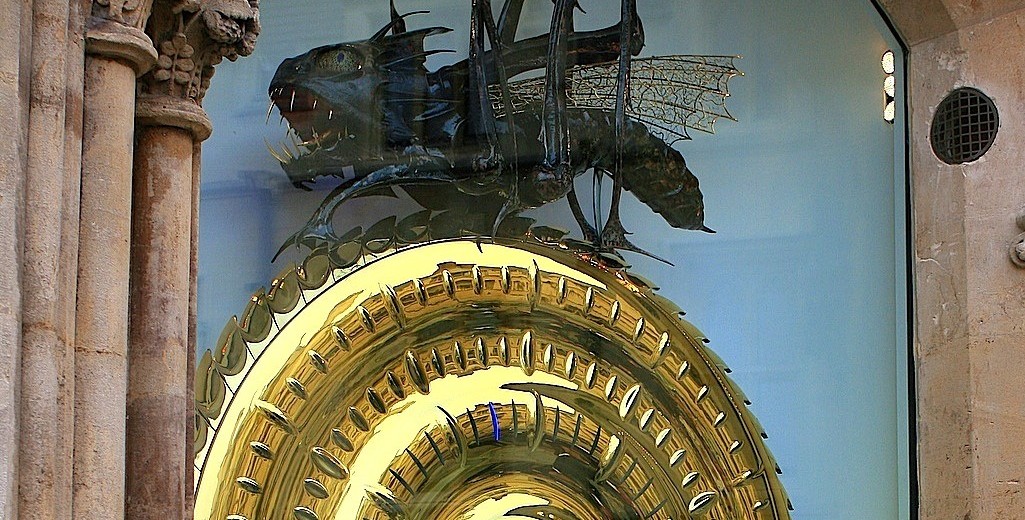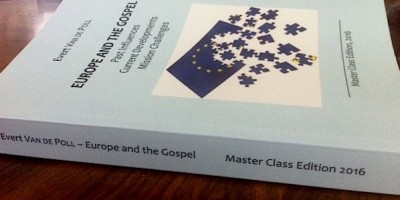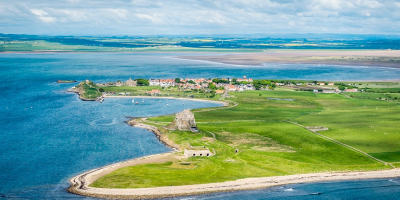Described as ‘terrifying and disturbing’, one of the world’s most unusual clocks never fails to draw perplexed visitors outside Corpus Christi College in Cambridge, as we observed walking through the university town on our recent Celtic Heritage Tour.
A fearsome giant locust of apocalyptic proportions rides astride a 24-carat gold-plated disc about 1.5 metres wide. Its sharp-fanged mouth appears to eat up the seconds as its legs relentlessly pull the disc in an erratic clock-wise motion, causing an eery and intermittent metallic sound.
Without hands or numerals, the clock displays the time via slits in the clockface lit by blue LEDs, in three concentric rings representing hours, minutes and seconds. On the hour, onlookers hear the clanking sound of a chain being lowered into a small wooden coffin behind the clockface.
The clue to understanding the designer’s intention is a Latin inscription below the golden disc: mundus transit et concupiscentia eius. Taken from the Vulgate translation of 1 John 2, verse 17, it reads: The world and its desires are passing away.
John Taylor, an alumnus of Corpus Christi College, conceived the idea of the clock as a work of art reminding passers-by that time too was inevitably passing by. He calls the locust the ‘chronophage’, literally the time-eater. Time, he believes, is not on our side. The ‘time-eater’ will eat up every minute of our lives, salivating for the next moment as he devours the present.
Officially unveiled in 2008 by the famed Cambridge physicist Stephen Hawking, it was listed as one of Time Magazine ‘Best Inventions of the year’. It took five years, one million pounds and two hundred scientists, jewellers, calligraphers, sculptors and engineers to produce.
Fascination and repulsion
Not everyone can appreciate all that investment of effort, time and money, however, as can be seen from remarks of visitors in this video. Reactions range from awesome fascination to disgusted repulsion.
The clock looks out across the King’s Parade where a blue plaque on the building opposite announces the original site of the White Horse Inn, popularly known as ‘Little Germany’. Here, the plaque tells its readers, the English Reformation was born. Cambridge scholars including Thomas Cranmer, William Tyndale, Nicholas Ridley and Hugh Latimer discussed the latest writings of Martin Luther over their jugs of beer. It was Thomas Bilney, himself awakened to the gospel message after working through Erasmus’ Greek New Testament, who gathered these friends in the White Horse Inn.
A decade earlier, Erasmus had lived and worked in Cambridge–despite his complaints about the undrinkable local beer and wine and local people who ‘combine extreme boorishness with extreme bad faith’–while working on his Greek and Latin parallel New Testament, which in turn was to inspire Luther’s German Bible and Tyndale’s English Bible.
Had Erasmus been able to walk out of the White Horse and see this clock, and the inscription from John’s first letter, he too would have been appalled at the vision of life presented. From his work on revising the Vulgate Latin text, he would have known that the verse goes on to say: ‘but he who does God’s will lives forever!’
Rich heritage
What a different perspective the full verse gives! Instead of a view of life as slipping away from us all, minute by minute, making our existence meaningless and futile, we discover a God who promises to repay us for the years the locusts have eaten (Joel 2.25).
The clock can be seen as a sad commentary on Cambridge today, on much of the academic world and on western society itself. Each having grown out of Christian roots, the university, academia and society have largely lost the transcendental dimension which gives meaning. The university coat of arms, for examples, shows a Bible at the centre; its motto is Hinc lucem et pocula sacra, ‘From this place, light and sacred draughts’. But sadly, the Bible no longer is central to the life of the university.
For Cambridge has a rich but oft-forgotten Christian heritage. An excellent place to begin exploring this is at the historic Round Church, built around 1130, now an exhibition centre explaining the story of the university’s founders who wanted to explore both God’s book of works and God’s Book of words.
In these days when we hesitate to watch the news for fear of yet another tragic mass killing, or of hearing one more political speech from a populist politician foreboding trouble ahead, we need to be reminded that in God’s plan the ‘time-eaters’ don’t have the last word.
Till next week,



